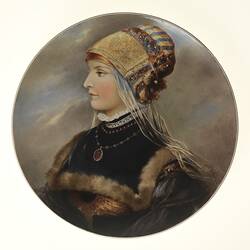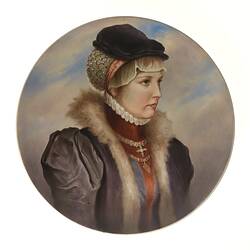Summary
Hand-painted Royal Vienna-style porcelain cabinet plate (one of three), depicting a woman richly clad in mid sixteenth century Germanic clothing, possbily after an orignial painting by Wilhelm Menzler (1846-1926), and manufactured circa 1880.
In 1718, the Dutch ceramist Claudius Innocentius Du Paquier, founded the Royal Vienna Porcelain Factory, drawing on the expertise of workmen from the other major European centre of porcelain production at Meissen, Germany, which itself had only been established eight years earlier. For almost a quarter of a century, Du Paquier's manufactory was the only other rival to Meissen producing genuine hard-paste porcelain before financial difficulties forced him to sell the business to the Austrian State in 1744. It continued under a series of directors until finally closing in 1865.
However, the term 'Royal Vienna' is still applied to porcelain made after this date, and by a range of manufacturers who continued to produce decorative porcelain vases, plates and plaques in a similar style. Painted porcelain 'cabinet plates' gained popularity in the second half of the nineteenth century, often being decorated with portraits copied from well-known paintings by a relatively small group of artists.
Although the original painting on which this plate's portrait remains unidentified, the related two Royal Vienna-style plates in the Twycross Collection depicting women in sixteenth century Renaissance dress are based on paintings by the German artist, Wilhelm Menzler, and examples of plates with this same portrait design have also been attributed to Menzler. Several similar examples of such plates are known, in some cases being signed 'W. Menzler', although the signature refers to him as the artist of the painting on which the plate design is based, and not the actual porcelain decorator.
Menzler exhibited two paintings at the 1879 Sydney International Exhibition, one a portrait of Philippine Welser (1527-1580), and the other a portrait of Agnes Bernauer, the so-called 'Beauty of Augsburg' (1410-1435), mistress of the later Albert III, Duke of Bavaria. His portrait of Bernauer was awarded a first prize and, both paintings were later reported in the Illustrated Sydney News as having been acquired by the New South Wales Academy of Art, the forerunner to the present Art Gallery of New South Wales.
Many of Menzler's paintings date to the late 1870s, and Royal Vienna-style cabinet plates carrying his designs would have been included among the exhibits at the 1880 Melbourne International Exhibition. Three Viennese firms were noted by Melbourne's Argus newspaper for their enamel and painted porcelain exhibits, Radler and Pilz, Charles Fab and Josef Zasche. It is possible these plates were purchased from one of them.
Physical Description
One of three wall plates, each painted with a portrait of a woman. Woman wearing rich red velvet stole and hat with feathers, pearl necklace and elaborate choker on green background.
More Information
-
Collection Names
-
Collecting Areas
-
Acquisition Information
Cultural Gifts Donation from Dr Will Twycross, 23 Jan 2009
-
Acknowledgement
Donated through the Australian Government's Cultural Gifts Program
-
Designer
-
Place & Date Made
-
Place & Date Exhibited
Royal Exhibition Building (REB), Nicholson Street, Carlton, Greater Melbourne, Victoria, Australia, 1880-1881
-
Collector
Mr John Twycross, Elsternwick, Greater Melbourne, Victoria, Australia, 1881
-
Inscriptions
Painted on underside in black: 52 Moulded on underside: (Star shape *) T A intersecting / 10
-
Classification
Royal exhibition building, International exhibitions, Exhibition heritage
-
Category
-
Discipline
-
Type of item
-
Overall Dimensions
290 mm (Width), 35 mm (Depth), 290 mm (Height)
-
Maximum dimensions
39 mm (Width), 260 mm (Circumference)
Measurement From Conservation.
-
References
Sydney Morning Herald, Monday 10 November 1879, p.6 'Austria', The Argus, Exhibition Supplement, Thursday, 9 December 1880, p.53 Illustrated Sydney News, Saturday, 20 November 1880, p.10 Illustrated Sydney News, Saturday, 20 June 1891, p.11
-
Keywords
Ceramics, Decorative Arts, Exhibitions: Melbourne International, 1880-1881, Royal Exhibition Building



